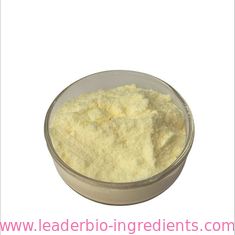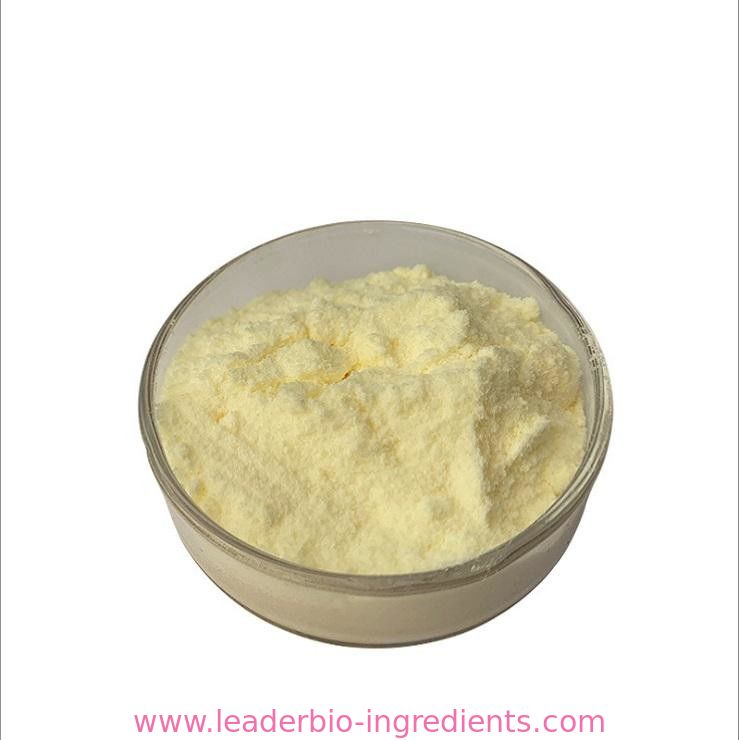| Chemical Properties |
Yellow to orange/yellow crystalline powd |
| Chemical Properties |
VITAMIN B2 (Riboflavin). Some earlier designations for this substance included vitamin G, lactoflavin, hepatoflavin, ovoflavin, verdoflavin. The chemical name is 6,7-dimethyl-9-d-l’ribityl isolloxazine. Riboflavin is a complex pigment with a green fluorescence. |
| Originator |
Hyflavin ,Endo,US,1948 |
| Uses |
Vitamin B2 (riboflavin) is produced by yeast from glucose, urea, and mineral salts in an aerobic fermentation. |
| Uses |
Nutritional factor found in milk, eggs, malted barley, liver, kidney, heart, leafy vegetables. Richest natural source is yeast. Minute amounts present in all plant and animal cells. Vitamin (enzyme cofactor). |
| Uses |
Vitamin B2; Vitamin cofactor; LD50(rat) 560 mg/kg ip |
| Uses |
riboflavin (Vitamin B2) is used in skin care preparations as an emollient. It can be found in sun care products as a suntan enhancer. Medicinally, it is used for the treatment of skin lesions. |
| Uses |
Riboflavin is the water-soluble vitamin b2 required for healthy skin and the building and maintaining of body tissues. it is a yellow to orange-yellow crystalline powder. it acts as a coenzyme and carrier of hydrogen. it is stable to heat but may dissolve and be lost in cooking water. it is relatively stable to storage. sources include leafy vegetables, cheese, eggs, and milk. |
| Definition |
ChEBI: D-Ribitol in which the hydroxy group at position 5 is substituted by a 7,8-dimethyl-2,4-dioxo-3,4-dihydrobenzo[g]pteridin-10(2H)-yl moiety. It is a nutritional factor found in milk, eggs, malted barley, liver, kidney, heart, and leafy vege ables, but the richest natural source is yeast. The free form occurs only in the retina of the eye, in whey, and in urine; its principal forms in tissues and cells are as flavin mononucleotide and flavin-adenine dinucleotide. |
| Manufacturing Process |
100 g of riboflavin and 3 of potassium carbonate are suspended in 500 cc of the aqueous formaldehyde solution and the mixture is stirred at 30°C for 8 hours. At the end of this period, 5 cc of glacial acetic acid and 1 liter of methanol are added, with stirring. The solution is freed from undissolved material by filtration and the clear solution is poured slowly at about 20°C to 22°C with vigorous stirring into 8 liters of anhydrous . The resultant precipitate is filtered off, washed repeatedly with anhydrous and with r, and then dried at room temperature and with vacuum. The resultant dried powder is dissolved in hot water at 95°C to give an aqueous solution of 20% by weight. This solution is kept in the dark at room temperature for 3 to 4 weeks, after which time a large amount of material crystallizes out of the solution. This crystallized material is removed by filtration and recrystallized from hot water. A small amount of dark red insoluble material is filtered from the hot solution. This recrystallization step is repeated four times. The resultant end product is monomethylol riboflavin, which crystallized in small orange clusters. It has a melting point of 232°C to 234°C with decomposition, and it becomes dark when heated above 225°C. |
| Brand name |
Flavaxin (Sterling Winthrop). |
| Therapeutic Function |
Enzyme cofactor vitamin source |
| General Description |
The conflicting results were eventually found to be due,in part, to deficiencies in study animals not just of vitamin B2,but also vitamin B3 (niacin), the cause of human forms of pellagra,and/or vitamin B6 (pyridoxine), another cause of dermatitis.Likewise, treatments with vitamin B2 were inconsistentbecause the early sources of this vitamin contained otherB vitamins. Vitamin B2 was eventually isolated from eggwhites in 1933 and produced synthetically in 1935. Thename riboflavine was officially accepted in 1960; althoughthe term was in common use before then. In 1966, IUPACchanged it to riboflavin, which is in common use today.Riboflavin is synthesized by all green plants and by mostbacteria and fungi. Therefore, riboflavin is found, at least insmall amounts, in most foods. Foods that are naturally highin riboflavin include milk and other dairy products, meat,eggs, fatty fish, and dark green vegetables.
Chemically, riboflavin is an N-glycoside of flavin, alsoknown as lumichrome, and the sugar, ribitol .Flavin is derived from the Latin word flavus for “yellow”because of the yellow color of its crystals and yellow fluorescenceunder UV light. Riboflavin is heat stable but easilydegraded by light. Its systematic names are 7,8-dimethyl-10-ribitylisoalloxazine and 7,8-dimethyl-10-(D-ribo-2,3,4,5-tetrahydroxy)isoalloxazine. |
| Clinical Use |
Severe riboflavin deficiency is known as ariboflavinosis, andtreatment or prevention of this condition is the only provenuse of riboflavin. Ariboflavinosis is most commonly associatedwith multiple vitamin deficiency as a result of alcoholismin developed countries. Because of the large numberof enzymes requiring riboflavin as a coenzyme, deficienciescan lead to a wide range of abnormalities. In adults seborrheicdermatitis, photophobia, peripheral neuropathy, anemia, andoropharyngeal changes including angular stomatitis, glossitis,and cheilosis, are often the first signs of riboflavin deficiency.In children, cessation of growth can also occur. As the deficiencyprogresses, more severe pathologies develop untildeath ensues. Riboflavin deficiency may also produce teratogeniceffects and alter iron handling leading to anemia. |
| Safety Profile |
Poison by intravenous route. Moderately toxic by intraperitoneal and subcutaneous routes. Mutation data reported. When heated to decomposition it emits toxic fumes of NOx. |
| Purification Methods |
It crystallises from H2O as a yellow-orange powder in three different forms with differing amounts of H2O. It melts if placed in an oil bath at 250o, but decomposes at 280o if heated at a rate of 5o/minute. It is also purified by crystallisation from 2M acetic acid, then extracted with CHCl3 to remove lumichrome impurity. [Smith & Metzler J Am Chem Soc 85 3285 1963.] Its solubility in H2O is 1g in 3-15L depending on the crystal structure. Its solubility in EtOH at 25o is 4.5mg in 100mL. Store it in the dark because it is decomposed to lumichrome by UV light. [Pearson The Vitamins vol V pp1-96 1967 and vol VII pp 1-96 1972, Gy.gy and Pearson eds, Academic Press, Beilstein 26 IV 2542.] |

